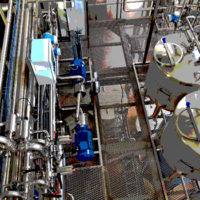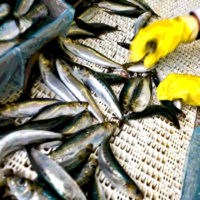In the food processing and manufacturing industry, there’s no such thing as being too safe. When it comes to keeping your products and your facility free of bacterial contamination, the risks are simply too great to be anything other than meticulous with sanitization.
The threats of sick customers, product recalls, lost profits, business interruptions, and damage to brand equity make it absolutely necessary to carry out a rigorous food safety plan. Regulatory penalties also may await any food processing facility without such a plan in place: Under the landmark Food Safety Modernization Act passed in early 2011, the U.S. Food and Drug Administration has the authority to require comprehensive, prevention-based controls across the food supply chain.
“Companies are expected to implement an effective food safety plan for their facilities with validated controls and measures in place to assure product and consumer safety,” said Paul Hall, Ph.D., a Pennsylvania-based food safety consultant and past president of the International Association for Food Protection. “It’s a business imperative that companies avoid recalls and invest in new technologies to ensure that their products and processing facilities are as free from pathogens as is practically possible.”
But as Hall and other food safety experts know too well, food processing environments still do become contaminated and recalls still do happen—even to companies that carry out laudable preventative measures.
In the United States alone, the Centers for Disease Control and Prevention (CDC) estimates 48 million cases of foodborne disease per year. That’s one out of six people affected, with 128,000 hospitalizations and 3,000 deaths that result. But this problem isn’t limited to the U.S.; it’s a serious and complex issue facing companies across the globe. And unfortunately, it’s much easier for the media to write dazzling news headlines about the problem than it has been thus far for the industry to resolve.
Fighting Back Against Listeria
When you examine the data on contaminations and recalls, you see that many different pathogens are at play. Salmonella leads the pack in terms of hospitalizations. Yet, it’s the robust and resilient Listeria monocytogenes that results in the most serious health reactions, according to the CDC. At greatest risk of becoming very ill from listeriosis are pregnant women, the elderly, newborns and others with weakened immune systems.
Unfortunately for food safety professionals, Listeria—which not just survives, but actually thrives in refrigerated environments—also is among the most troublesome to combat. This is particularly true for companies active in the expanding ready-to-eat food category, which was expected to generate a whopping $32.5 billion last year, according to a report by research firm Packaged Facts. The report notes that consumers are increasingly filling their shopping carts with pre-made salads, sandwiches, sushi and other foods that don’t need further cooking.
However, on the food safety side, these ready-to-eat delicacies are more susceptible to contamination than other types of food, a consequence of the additional handling required before they hit grocery store shelves. And, because these foods usually aren’t cooked again after being purchased, it’s more likely that any pathogens will survive and be ingested.
As food processing companies seek to isolate sources of contamination—be it Listeria, E. coli or something else—they often trace it back to food handlers at their facilities. In response, responsible companies are increasing their emphasis on food safety education for workers and enforcing more diligent preventative actions, such as handwashing.
But that isn’t enough. Food processing companies must take it a step further and scrutinize their plants’ sanitization systems to make sure they are performing extraordinarily well, assuming that human error can and will continue to introduce pathogens into the facility.
This level of scrutiny uncovers, in some cases, that conventional sanitizers are falling short in one or more areas. A piece of the puzzle is missing. And that’s risky business.
Hungry for a New Solution
As a result, food safety professionals are seeking better options in pursuit of peace of mind that they’re doing everything they can to protect their customers and their brand. They want a plan that accounts for dangerous microorganisms that may be hiding in unexpected and hard-to-reach places, inaccessible by their current methods.
Recognizing this need, a company with a record of market-focused innovation has emerged in the food safety industry with a novel solution. Encouraged by successful trials with well-known food brands, Dow Microbial Control—a business unit of The Dow Chemical Company—in July 2013 launched an automated sanitization system that leverages the power of ozone to swiftly kill bacteria on surfaces and in the air.
Advanced Oxidation System (AOS) Certified technology for whole room sanitization converts ambient air into ozone and combines it with a non-condensing humid atmosphere to create a vapor that completely fills the room. This vapor reaches deep into every corner, rapidly penetrating hidden areas in equipment, drains, air conditioning vents and fabrics. The sanitizer then fully dissipates, leaving no condensation or residues, making it safe even for dry environments such as bakeries.
“The efficacy of ozone in a high-humidity environment has been demonstrated in both laboratory and field trials, for both food contact surface disinfection and the disinfection of the production environment, including areas that are hard to clean and disinfect,” said Lawrence Staniforth, contracts manager within the Heat Resistance and Decontamination group at Campden BRI, the United Kingdom’s largest independent organization carrying out research and development for the food and drinks industry. Campden BRI, which assesses technologies but does not endorse specific products, tested AOS in laboratory trials at its testing facilities and found that the system reduced the contaminating organisms dried onto stainless steel surfaces both in exposed and hard-to-reach places, according to Staniforth.
The sustainability factor is also worth noting: Unlike other vapors used for sanitization, the AOS Certified system produces its sanitizing agent on demand and does not require shipping, storage or handling of chemicals. In other words, it’s easy on the environment and the people who use it.
“Our ozone-based system is unique in that it essentially harnesses and controls a naturally occurring process that leaves very minimal imprint on the environment,” said Bryan Kitchen, global business manager for Advanced Oxidation Systems, Dow Microbial Control. “In this case, the forces of nature happen to be extremely successful in reducing the resilient microbes that are causing big problems for food processing companies.”
Why Ozone, Why Now?
Ozone, a molecule composed of three atoms of oxygen, is among the most powerful oxidizing reagents available in the food industry—more powerful than substances such as hydrogen peroxide, permanganate, chlorine dioxide, hypochlorous acid and chlorine gas.
Because of its antimicrobial powers, ozone has been used for more than 100 years as a sanitizing agent in applications such as drinking water and wastewater treatment. Historically, the biggest downside of using ozone is difficulty in distributing it evenly and reliably to the areas that need to be treated. When applied uniformly, it’s proven to be extremely effective. But that’s been problematic using the technologies of the past.
Dow Microbial Control has been able to overcome that challenge through innovative science. To develop AOS Certified technology for whole room sanitization, Dow Microbial Control worked closely with a team that includes top microbial control scientists and ex-NASA engineers who have extensive controls and integration expertise. The result is a system that precisely controls ozone dosing, room humidity, and process time. It monitors the entire treatment cycle. And when the cycle is finished, it certifies the treatment.
In the food safety industry, which is so diligent about sharing technologies that work, AOS Certified technology for whole room sanitization is a new solution worth talking about.
“The food and drinks industry is always keen to hear about new technologies and approaches to achieving good hygiene,” Staniforth said. “New approaches to disinfection, including tackling microbial strains that might persist in the production environment, are likely to prove to be of increasing interest.”
There can be no more tolerance for Listeria, E. coli, Salmonella and other pathogens that are putting customers and companies at risk. The industry is ready for a revolutionary new innovation to solve its toughest problem. Businesses and lives may depend on it.
Tony Reed is the business development manager for food safety at Dow Microbial Control.
New to Food Safety, But Not New to Food
With AOS Certified technology for whole room sanitization, Dow enters the food safety market for the first time. But in many other segments of the food industry, Dow is already an established and well-respected player. Commercial bakeries use Dow’s plant-based gluten replacement to help gluten-free bread, pasta and dough taste more like the real thing. Dow’s healthy Omega-9 canola oils are used by restaurants and food manufacturers, helping eliminate more than 1 billion pounds of bad fats from the North American diet. Earlier in the food chain, Dow’s agricultural innovations help farmers grow healthy grains, fruits, and vegetables. Dow also comes to the aid of farmers and packer-shippers with its SmartFresh technology, which controls fruit and vegetable ripening to improve retail quality. And before many foods end up in the store, the industry relies on Dow’s high-performance packaging technology to help food stay fresh longer, reducing waste from spoilage.




